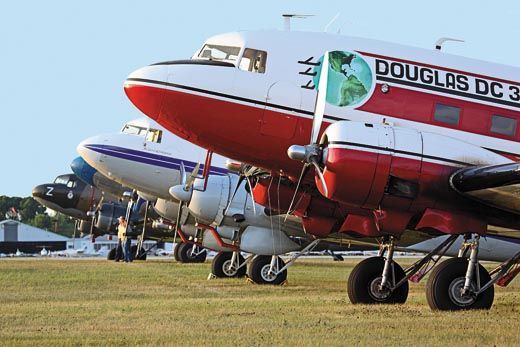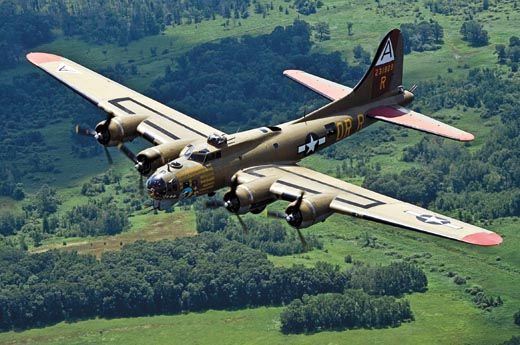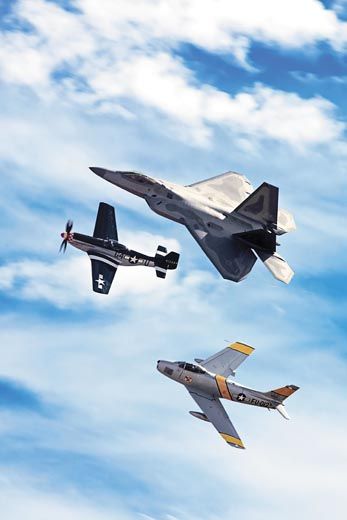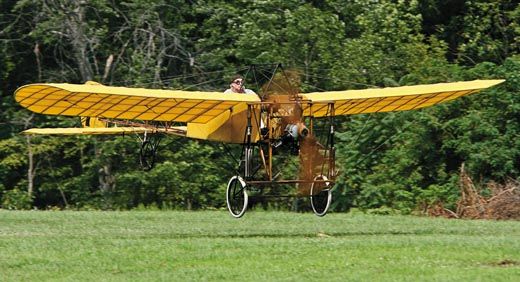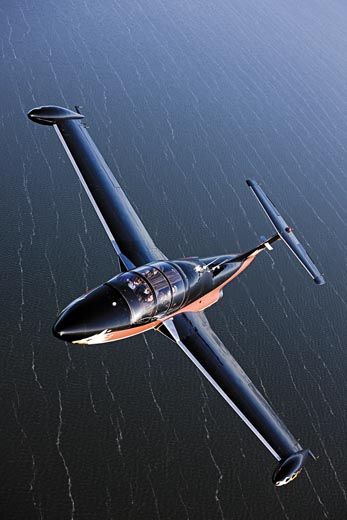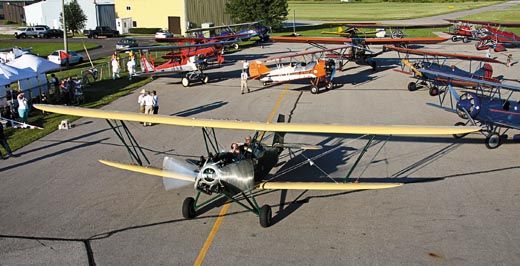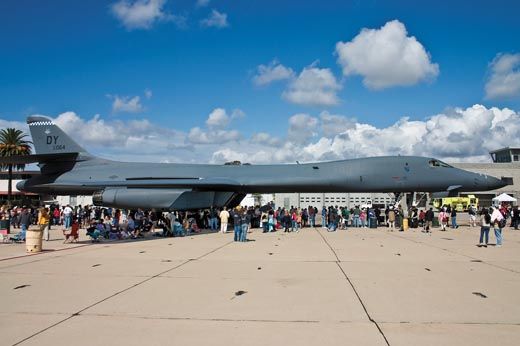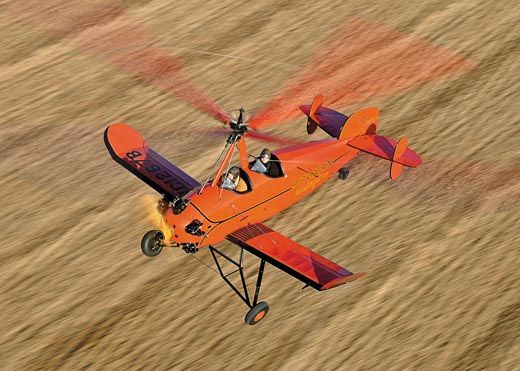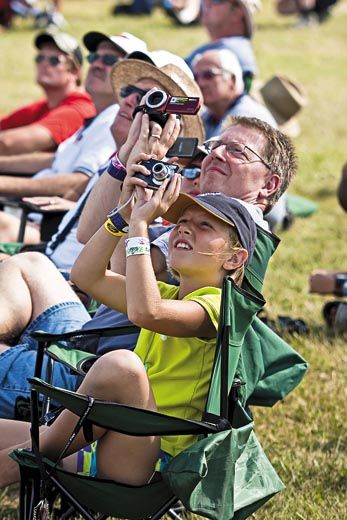Let the Shows Begin!
What’s hot on this summer’s airshow circuit.
/https://tf-cmsv2-smithsonianmag-media.s3.amazonaws.com/filer/Airshow2010%20FL.jpg)
Since January 1910, when audiences crowded the bleachers for what promoters called an “aviation tournament” in Los Angeles, Americans have made flying a favorite spectator sport. But U.S. airshows do more than entertain. They inform audiences about airplanes in the current U.S. military inventory and educate them about aviation history. All U.S. services send aircraft to shows for static displays, so fans can get a close look
at what their tax dollars bought—and can pepper the pilots with questions. Shows also let owners of rare, vintage aircraft show off their beauties. We’ve canvassed airshows across the land to find out what will dazzle the fans this year. Flying or not, these airplanes are worth a trip to a local show, where you can gawk to your heart’s content.
—The Editors
In the Beginning, There Was Blériot
1909 BlÉriot XI (and other vintage aircraft and reproductions)
Approximately the front third and rear third of Old Rhinebeck’s Blériot was original when it was donated in 1952. It is the oldest airworthy aircraft in the United States.
It has been my honor to fly the Blériot at Old Rhinebeck. Since it has no flying instruments, I have no idea how fast it flies, but would guess around 30 mph. At such slow speeds, the wing warping it uses for roll control is marginally effective. The four-cycle, 35-horsepower engine has a single magneto and starts and runs well, but having only three cylinders, it fires every 240 degrees of rotation—which is to say firing is not the smoothest. Who knows how much horsepower it still produces? The aircraft barely makes enough speed for takeoff, and with its highly cambered airfoil, it seems to levitate as much as fly. In flight it feels like I imagine a butterfly would, affected by the slightest wind change. The margin between stall and level flight is only a couple of knots. I don’t recommend flying the Blériot any higher than you are willing to jump.
The landing gear is nicely sprung on bungees, so the airplane lands graciously. The gear will caster for any drift, which makes for a nice crosswind touchdown, but also a total lack of directional control. On the ground, the airplane cannot be manuevered unless people hold the wingtips.
The Blériot is the worst-flying airplane I have flown, and one of the most satisfying. Sitting in its wicker seat, surrounded by a century of incredible history and patina, I fly it with the same anticipation of the unknown as Louis Blériot must have felt.
-- Hugh Schoelzel, president, Old Rhinebeck Aerodrome Air Shows
- Old Rhinebeck Aerodrome, Norton Road, Rhinebeck, New York (Exit 19, New York State Thruway) Shows every Saturday (History of Flight 1909–1939) and Sunday (World War I), June 12 through Oct. 17, 2–4 p.m., weather permitting. Museum open daily 10 a.m.–5 p.m.
When the Raptor Arrives, Look Up
Lockheed Martin F-22A Raptor
When the U.S. Air Force F-22 Raptor comes to an airshow, static displays don’t cut it; you have to see it fly. Since 2006, U.S. Air Combat Command has been sending its premier air dominance fighter to perform at airshows—12 in 2009—perhaps to build support for adding more F-22s to the inventory. (That dream died with a Senate vote last July to hold production at 187 aircraft.) With thrust-vectoring engines that together produce 70,000 pounds of thrust, the Raptor combines agility and power in an aerobatic display that nothing else on the show circuit can approach. In one of its most breathtaking maneuvers, the F-22 does a vertical climb, pauses and hangs at the top for what seems like seconds, then executes the tightest somersault you’ll ever see a fighter perform. When it resumes flying like a normal airplane, the audience feels a sense of relief, and the pilot gives a wink by cycling the bomb-bay doors.
Demo pilots are fond of saying that the super-maneuverability they exhibit at airshows, while handy in the unlikely case of a dogfight, isn’t the quality that will make the Raptor dominant in combat. What makes it fearsome are its speed, stealth, and networked avionics. What scares adversaries about the F-22? The one that shoots you is not the one you see.
On the ground, don’t try to sneak up behind a Raptor with a camera. In fact, you can’t. The Air Force is very protective of the classified thrust-vectoring hardware in the engine exhaust nozzles. You can only gawk at the Raptor head-on.
- Visit www.acc.af.mil/aerialevents/f22a for updates on where the F-22 will perform.
Love Is a Many-Bladed Wing
1932 Pitcairn PA-18 Autogiro
Over the past 11 years, Jack Tiffany, working with the Leading Edge Aircraft restoration crew in Spring Valley, Ohio, led an effort to return a Pitcairn PA-18, the model Tiffany says was meant to be Everyman’s Autogiro, to flying condition. “Been enamored by autogiros all my lifetime,” Tiffany says. “Evidently as a child I saw one fly at Wright Field when the Army Air Corps was testing them. I was told I saw it fly; I don’t remember!”
What Tiffany restored is a descendant of the aircraft that aeronautical engineer Juan de la Cierva first demonstrated in 1923, when he introduced rotary-wing flight to Spain. Six years later, American aircraft designer Harold Pitcairn purchased the rights to Cierva’s invention, and in the early 1930s he built some 50 autogiros, some for private use, some for the U.S. Navy. Ultimately, the technologies derived from the development of the autogiro gave rise to the practical helicopter.
Tiffany’s stepson first alerted him to the autogiro’s existence in Mojave, California. “We drug the carnage home and pulled it in the shop,” says Tiffany, “and [Leading Edge crew member] Don Siefer put numbered tags on every part and took photographs of it before he’d let us touch it.”
Well before Tiffany even thought he might someday find an autogiro, he called Harold Pitcairn’s son, Steve, looking for drawings. “I told him I’d like to build one. He said, ‘You could not build that airplane without one to look at, even if you have a plan in your hand. It is unbelievably complicated.’ And I’d been building airplanes for 30 years.”
Challenges included identifying, locating, and fabricating parts, virtually all of which were unique to the autogiro. The fuselage required welding repair, and the rotor dampeners had to be rebuilt. “We hunted for the rotor brake—it turned out to be a Crosley brake, and there were a lot of Ford car parts in it too,” says Tiffany. We had the biggest problem with the mast head that the rotor attaches to—it is a weldment, or tubing that is jigged up and welded together at precise tolerances. Nothing was square; it had to lean over a degree and a half, it had to tilt back two degrees, and then it had to be welded to the front and rear mast poles. It was a nightmare; we went to four different machine shops, and all of them threw up their hands and gave it back to us. A machinist in Albuquerque ended up making it.”
Other hurdles included satisfying Federal Aviation Administration paperwork requirements so that Tiffany and his partner on the project, Jim Hammond, could register the autogiro and then apply for its airworthiness certificate; and finding someone qualified to fly it. To fly such an aircraft, a pilot must have a rotorcraft-gyroplane rating. Virginia resident Andrew King was willing to complete his instruction and check ride in Alabama.
King says that flying the PA-18 is “like being carried off by a prehistoric bird. There are these little tiny wings out there. When I turn, the shadow of the rotor blades is moving so slowly across the wing, you think: That can’t be holding this thing up either. It flies pretty well.”
-- Sparky Barnes Sargent
- Sun ’n Fun, Lakeland, Florida, April 13–18
On the Road Again
Middle America, this one’s for you: a traveling airshow that re-creates a time when an airplane landing near your town was the event of the summer, and townsfolk watched the horizon for the return of the barnstormers. This summer the American Barnstormers are flying 20 Golden Age charmers on a seven-city tour across the northern Great Plains. Love open-cockpit flying? On this third tour, the American Barnstormers will once again sell biplane rides in a Travel Air, New Standard, or Stearman.
- Mason City Airport, Mason City, Iowa June 17–19
- Marv Skie-Lincoln Airport, Tea, South Dakota June 20–22
- Watertown Regional Airport, Watertown, South Dakota June 23
- Aberdeen Regional Airport, Aberdeen, South Dakota June 24–26
- Bismarck Airport, Bismarck, North Dakota June 27–29
- Jamestown Regional Airport, Jamestown, North Dakota June 30–July 2
- Chandler Field Airport, Alexandria, Minnesota July 3–5
Bone Is the New Black
Boeing (Rockwell) B-1B Lancer
Rumor has it that the B-1 got its insider nickname, Bone, from a newspaper story that spelled out its designation as “B-One.” What is known for certain is that all the cool kids prefer Bone to the official Air Force name, “Lancer.” Designed as a long-range strategic nuclear bomber and declared operational in 1986, the variable-sweep B-1B was converted to a conventional bomber at the end of the cold war. With its wings swept, the Bone can reach 900 mph at sea level, but over most locales such fly-bys are forbidden because they cause sonic booms. But even when it’s just sitting on the ramp, the elegant matte-black B-1B is a real eyeful.
- Dyess Big Country Airfest, Dyess Air Force Base, Abilene, Texas, May 1 Static display and flybys
- SkyFest 2010, Fairchils Air Force Base, Spokane, Washington, July 24 and 25, Static display
Jumping Jet Flash
BAE Systems FA2 Sea Harrier
The prototype of the Harrier jump jet, the Hawker P.1127, debuted in 1960 in the United Kingdom, and the United States soon jumped in with both feet: By the early 1970s, the vertical-takeoff-and-landing Harrier was flying with the Royal Air Force and the U.S. Marine Corps. (The Marine Corps always gets the divas: the Corsair, the Harrier, the Osprey.) McDonnell Douglas teamed with British Aerospace to produce the upgraded AV-8B Harrier II, which has been operating since 1985.
When some Harriers reached retirement age, a U.S. civilian decided he had to have his very own diva. The vertical-takeoff-and-landing Sea Harrier, a British naval version of the Hawker Siddeley
Harrier GR1, is best known for its performance in the 1982 Falklands War with Argentina. The Royal Navy retired the aircraft in 2006, whereupon Art Nalls, who had logged 1,800 hours in U.S. Marine Corps Harrier AV-8As and Bs, bought one through an aircraft broker working with the British Ministry of Defence. The 120-decibel (chainsaw-loud) jet made its civilian debut in October 2008, and flew six shows in 2009. Nalls told one of the airshows where he demonstrates the airplane that he needs money to help cover costs such as fuel—the airplane burns nearly two gallons per mile. “They gave me a set of Legos last year,” he says, “and it’s the thought that counts.”
Art Nalls and his Sea Harrier will appear at:
- Wings Over Pittsburgh, Pennsylvania, Sept. 11
- Culpeper AirFest, Brandy Station, Virginia, Oct. 9
The Marine Corps demonstrates its AV-8B Harrier at the following shows:
- Florida International Airshow, Punta Gorda, April 10 & 11
- Central Texas Airshow, Temple, April 30–May 2
- Department of Defense Airshow, Andrews AFB, Maryland, May 15 & 16
- Salute to Veterans, Columbia, Missouri, May 29 & 30
- Golden West Regional Fly-in, Marysville/Olivehurst, California, June 11–13
- Battle Creek Airshow, Michigan, July 1–4
- Gary Airshow, Indiana, July 10 & 11
- Arctic Thunder, Anchorage, Alaska, July 31 & Aug. 1
- Oregon International Airshow, Hillsboro, Aug. 20–22
- Atlantic City Airshow, New Jersey, Aug. 25
- New York City Airshow, Brooklyn, Aug. 28 & 29
- Little Rock Air Force Base Airshow, Arkansas, Oct. 9 & 10
Happy 75th Birthday
Douglas DC-3, Boeing B-17
For U.S. aviation, 1935 was a very good year. It was the year that C.R. Smith, the new president of up-and-coming American Airlines, got an edge on his competition. Hoping to win customers by offering more comfort on long coast-to-coast trips, Smith asked Donald Douglas to design a modern “sleeper,” so passengers could spend part of the journey tucked into Pullman car-type berths. Douglas answered, reluctantly, with the Douglas Sleeper Transport, which, in its daytime configuration, was the 21-passenger DC-3 (“DC” for Douglas Commercial). Its first flight was December 17, 1935, the anniversary of the first flight, and six years later, 80 percent of the airliners flying in the United States were DC-3s. It was the first airliner that made money for its operators from passenger fares alone, independent of mail contracts. Airplane fans have loved it from the beginning.
Also in 1935, just five months before the DC-3 made commercial aviation profitable, Boeing Aircraft Company launched the B-17, the aircraft that would determine the course of U.S. military aviation. The country’s first operational four-engine bomber took off from Seattle’s Boeing Field on July 28, 1935; more than 12,700 (some built by Douglas and Lockheed) would follow. A Seattle Times reporter coined the name “Flying Fortress,” but he could not have foreseen how vulnerable the bomber crews would be to anti-aircraft guns and enemy fighters in World War II. As wave after wave of B-17s—some formations more than 200-strong—began to pound German industrial centers in 1943, losses were so heavy that missions were curtailed. (Once the P-51 Mustang fighter began escorting the bombers, their chances of survival improved.) The drama of those missions and the B-17’s good looks made it a media darling, and today a dozen U.S. organizations fly restored B-17s as symbols of sacrifice and triumph.
This July, at the 2010 Experimental Aircraft Association’s AirVenture fly-in at Oshkosh, Wisconsin, the DC-3 and B-17 will get together to celebrate their 75th birthdays. Some 25 DC-3s will fly in, and the EAA expects several B-17s to show up.
These organizations fly B-17s; some sell flights and post tour schedules on their Web sites:
- 1941 Historic Aircraft Museum, Geneseo, New York
- Collings Foundation, Stow, Massachusetts
- Commemorative Air Force, Midland, Texas
- Commemorative Air Force, Mesa, Arizona
- Evergreen Aviation Museum, McMinnville, Oregon (this year: only static display)
- Experimental Aircraft Association, Oshkosh, Wisconsin
- Liberty Foundation, Tulsa, Oklahoma
- Lone Star Flight Museum, Galveston, Texas
- Lyon Air Museum, Santa Ana, California
- Palm Springs Air Museum, Palm Springs, California
- Vintage Flying Museum, Fort Worth, Texas
- Yankee Air Museum, Ypsilanti, Michigan
Paris + Jet =Trés Magnifique
MS760
It doesn’t hover or breathe fire or autorotate, but when it debuted in the 1950s, the world’s first Very Light Jet was very far ahead of its time. The Morane Saulnier Paris MS760 was designed as a jet trainer to meet a French military contract, but it lost the competition. Beech Aircraft bought a few and demonstrated them as business jets Stateside, but the Learjet soon eclipsed the Frenchie. Late last year a U.S. entrepreneur announced plans to update 32 Paris jets and sell them for about $550,000 per (training included). A two-ship precision-flight team, led by former F-14 demo pilot extraordinaire Dale Snodgrass, is flying the circuit this summer.
- Sun ’n Fun, Lakeland, Florida, April 13–18
- Air Lauderdale Beach Fest, Ft. Lauderdale, Florida, April 24 & 25
- Sun Fun Festival Airshow, Myrtle Beach, South Carolina, May 28 & 29
- Borden Canadian Forces Day, Canadian Forces Base Borden, Ontario, June 5 & 6
- Rhode Island National Guard Open House, North Kingston, June 26 & 27
- EAA AirVenture, Oshkosh, Wisconsin, July 26–Aug. 1
- Atlantic City Airshow, New Jersey, Aug. 25
- Boston-Portsmouth Air Show at Pease, Portsmouth, New Hampshire, Aug. 28 & 29
- Naval Air Station Oceana Air Show, Virginia Beach, Virginia, Sept. 18 & 19
- National Business Aviation Association Convention, Atlanta, Georgia, Oct. 19–21
- Wings Over Homestead, Homestead Air Reserve Base, Florida, Nov. 6 & 7
